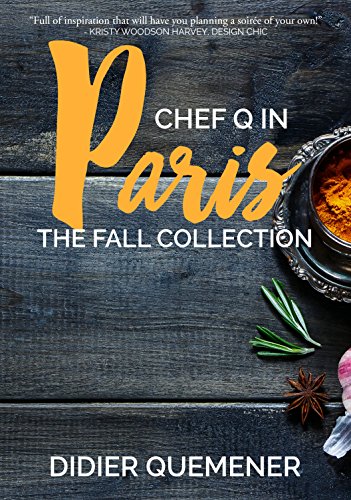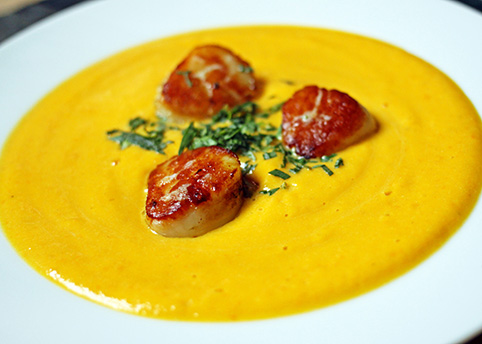The days grow longer, colder, tinged with the slightest hint of winter chill. We are back in the kitchen, full steam ahead making soups, stews and anything that uses the best of fall ingredients.
Enter Chef Didier Quemener who will be your guide to what to cook now with recipes from his latest book, Chef Q in Paris: The Fall Collection. Once you have devoured these recipes, you can graduate to his sequel just in time for the heart of winter: Chef Q in Paris: The Winter Collection, (Velvet Morning Press).
 Meet Chef Q
Meet Chef Q
There isn’t much Chef Didier Quemener, with the handle “Chef Q,” is not doing in the food world these days. He is a cookbook author, culinary teacher, wine tasting leader and food market tour aficionado.
French Culinary Influence
Born in France and raised on his grandmother’s cooking, Chef Q discovered his love for the culinary arts at a young age.
In fact, he often cites his grandmother as one of the biggest inspirations in his life: “…because she was cooking with me from the age of seven years old. I was always in the kitchen with her, no matter what time of the year it was. I truly believe that my inspiration from the country-style type of cooking comes from her because I was there all the time.”
France Meets Italy
Yet, his grandmother wasn’t the only woman who influenced his cooking: “When I moved to the U.S. for the first time, I met my family-in-law, my wife’s mother and grandmother, who were from Italian background. So, they taught me even more in terms of cooking, linked to their origins, and Italian cuisine.”
The Birth of Chef Q
In 2008 Quemener, who holds a literature degree from Sorbonne University, transformed his passion into his job when he founded Bulle & Sens, now known as “Chef Q,” a private chef service.
In 2012, Chef Q created the Food Me website, a French and English website all about food. He’s worked on pastry documentaries, episodes of Kitchen Impossible with Chef Michel Roux Jr, and, in 2016, he taught courses at the Michel Roux Jr. Cookery School in London.
Recently, Chef Q has also published his own series of cookbooks. These seasonal cook books herald his philosophy of cooking with the seasons. According to Chef Q: “The idea is to create a book for every season, so that people can really attach themselves to some type of cooking according to the products.”
It’s All About Soup
So, what’s the best recipe for the fall season? According to Chef Q, it’s all about soup.
“In the fall season, I always like to have a good, regular bowl of soup, and a couple of slices of bread. Dinner time, I always enjoy starting dinner with a bowl of soup.”
In order to celebrate the remaining days of the fall season, he’s agreed to share his recipe for Hokkaido Squash Velouté with Scallops.
Hokkaido squash, is also called Japanese squash (uchiki kuri squash), orange squash, or baby red hubbard squash, “Kuri” means chestnut, the dominant flavor of this delicious teardrop-shaped squash. And yes, it is considered a fruit, just like pumpkin, avocado, beans, peapods, corn kernels, cucumbers and tomatoes.
As for nutritional value, this squash is a good source of vitamin A and vitamin C, as well as potassium and iron.
It’s healthy and tasty. Uncut, Hokkaido squash will keep for several months in cool, dry storage.
Enjoy this succulent soup, brought to you straight from the streets of Paris by Chef Q and check out his latest books all on Amazon.
Hokkaido Squash Velouté with Scallops
Makes 4 servings
1 medium size Hokkaido squash
1 tablespoon butter
1 shallot
1 quart whole milk
Zest of ½ lemon
1 pinch ground nutmeg
12 bay scallops
2 tarragon stems
Salt and pepper to taste
Preheat oven to 425° F.
Wash squash, halve it and remove seeds.
In a large saucepan, melt butter on medium heat. Chop shallot and add it to the melted butter. Cook for 5 minutes, tossing from time to time.
During that time, cut squash in big chunks. Do NOT peel it; when peeled, it loses all its flavor. Add squash pieces and 2 pinches of salt to the pan. Cook for another 5 minutes, tossing with a wooden spoon.
Add milk, lemon zest and nutmeg. Milk should slightly cover squash. Bring to a boil. Then cook for 20 minutes, covered, on low heat.
On a non-stick baking sheet, roast scallops for 5 minutes on each side.
Blend soup (to make sure squash is fully cooked, use a knife to check if it is tender all the way through) using an immersion blender or traditional blender.
Remove tarragon leaves from the stems and chop finely.
Pour soup in deep dishes, add 3 scallops per person, sprinkle tarragon on top, and add pepper to taste.
Didier’s tips:
Give your soup a festive flavor by replacing lemon zest and nutmeg with orange zest and cinnamon. And if you can’t find Hokkaido squash, you can substitute with other types of winter squash, such as butternut.
Reprinted with permission from Chef Q in Paris: The Fall Collection © 2016 by Velvet Morning Press.












